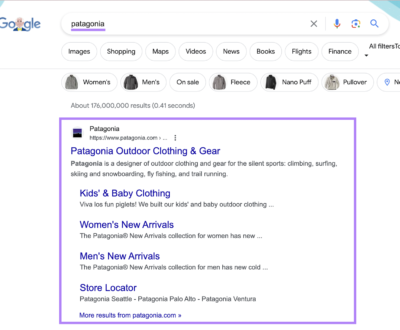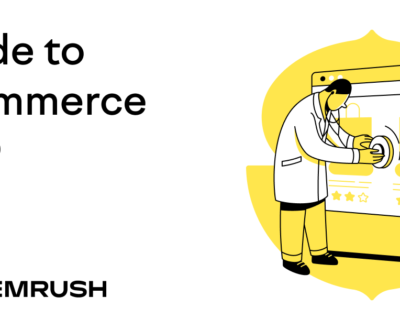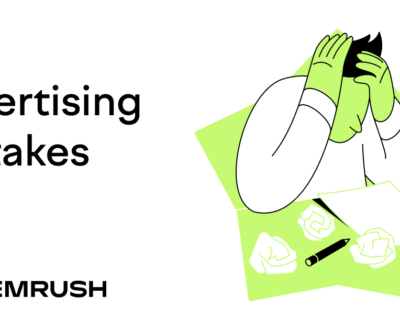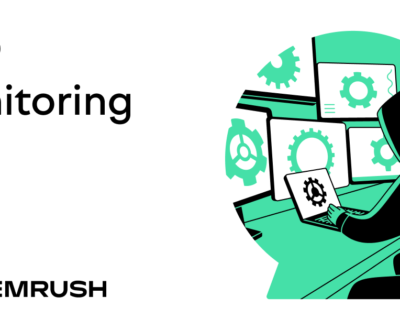[ad_1]
In the process of creating a digital marketing strategy, most companies conduct a digital marketing competitor analysis.
Digital marketing competitor analysis allows you to develop an understanding of the competitive landscape, your competitors’ best marketing practices, and the pitfalls to avoid. Using this data, you can craft your own online marketing plan and get the ball rolling.
In this article, we’ll explore the why and how of digital marketing competitor analysis and look at how to improve your own digital marketing strategy using the Semrush .Trends digital analytics tools. Let’s get started!
What is Digital Marketing Competitor Analysis?
Let’s start with the basics: What is digital marketing competitor analysis?
Competitor analysis is the process of researching your market to identify competitors, unpacking the characteristics of competitors’ businesses, and analyzing their strategies.
Competitor analysis is typically carried out to identify the strengths and weaknesses of other market players, define your company’s standing in relation to them, and highlight gaps and estimate your potential to fill them.
Competitor analysis in the digital marketing context has some unique characteristics because of the fast-changing nature of the online landscape.
Digital markets can evolve rapidly and technology allows businesses operating in the digital landscape to pivot in an instant. That said, unlike traditional marketing channels, digital platforms offer an abundance of data and metrics that can be harnessed to gain insights into competitors’ strategies.
Who Should You Analyze as Competitors in Digital Marketing?
Once you decide competitor analysis is necessary for your online marketing plan, you need to figure out who your competitors in digital marketing actually are.
If you’ve been running your business online for a while, a few digital competitors may come to mind right away. But it’s important not to rely just on your experience and intuition. You may be surprised by who you’re actually competing with in terms of traffic acquisition.
Direct Competitors, Indirect Competitors, & Brand Competitors
Competitor analysis normally includes a close look at both direct competitors and indirect competitors. Then, there are brand competitors. We’ll look at how to pinpoint competitors later, but for now, let’s define our terms:
- Direct Competitors–Businesses that offer similar products or services and target the same customer segment, competing directly with each other for market share.
- Indirect Competitors–Businesses that offer different products or services, but target the same or similar customer segment, potentially fulfilling similar needs or providing substitute solutions.
- Brand Competitors– Brand competitors are much like direct competitors. The difference is brand competitors have established strong brand identities and customer loyalty, setting themselves apart through reputation and unique value propositions.
When it comes to digital marketing, traffic is the name of the game. Whether you’re analyzing advertisements on social media, organic traffic from Google, or referrals from other domains, your competitors are those websites that are drawing traffic away from your site to their own.
How Are Digital Marketing Competitors Different from Other Kinds of Competitors?
Digital competitors in online marketing compete for the same audience through digital channels and strategies like social media, SEO, PPC, email, and content marketing.
On the other hand, non-digital competitors are focused on traditional channels like TV, print media, radio, billboards, and physical stores to reach their audience.
The key difference lies in the channels they use:
- Digital Competitors: Utilize online platforms like websites, social media, mobile apps, and email marketing.
- Non-digital Competitors: Focus on offline channels such as TV, radio, print, direct mail, and physical storefronts.
Remember, some businesses may be competitors only in the digital realm, without affecting your offline presence.
Why Is Ongoing Competition Tracking important?
While your main competitors are not likely to change that much over time, their positions and the general market conditions will shift constantly.
Here are the key reasons to check up on other market players on a regular basis:
- To review benchmarks– From monitoring your internal stats, you know which channels perform best. But what if your competitors have managed to achieve even better results? You need to know what they’re doing to stay on the cutting edge with your strategy.
- To catch up with industry and market trends– There are some seasonal trends that reoccur every year, and there are peaks and declines in demand that you will be prepared for only if you monitor the competitive landscape. Make sure to stay alert.
- To learn the best new practices and the mistakes to avoid– Experimentation is key in marketing, but you can only do so much with the budget you have. Sometimes it’s a good idea to let your competitors test new channels rather than go there yourself and waste your budget. Learn from other companies’ experience.
- To stay on top of competitor activity– From digital marketing campaigns you can get some important news on your competition, such as a new product launch, and get ideas for your own company’s development.
- To refine your goals–As the situation in the online market changes, you may need to adjust not just your strategy, but also the objectives you previously set.
Digital Analytics: Deciding What Competitor Activity to Analyze
Digital analytics provides you with a wealth of information about your competitor’s online presence, customer behavior, and campaign performance. However, with so much data available, it’s crucial to know what to measure and why. In this section, we’ll explore key metrics and measurements that are essential for effective digital analytics.
What to Measure:
- Competitive Landscape Dynamics–Monitoring competitor roles in the marketplace and how their traffic has grown or declined over time can help you pinpoint players to watch and study.
- Website Traffic–Monitoring the number of visitors to a competitor’s website is fundamental. It helps you understand the reach and popularity of their presence, and provides insights into user behavior.
- Traffic Channel Breakdowns–Measuring traffic channel breakdowns allows you to gain valuable insights into the performance of different acquisition channels and make data-driven decisions to enhance your digital marketing strategies.
- Engagement Metrics–Measuring metrics like bounce rate, time on site, and page views per session provides insights into how users interact with your competitors’ website. It helps identify areas for improvement and optimize user experience.
- Social Media Metrics–Monitoring social media engagement, follower growth, likes, shares, and comments helps assess the impact of your social media presence and content strategy.
- Email Campaign Metrics–Tracking email open rates, click-through rates, and unsubscribe rates helps evaluate the effectiveness of your email marketing efforts and refine your email campaigns.
- Conversion Rates–Tracking conversions, such as purchases, sign-ups, or form submissions, allows you to gauge the effectiveness of your competitors’ marketing strategies in driving desired actions.
By understanding what to measure and why, you can unlock the power of data and leverage digital analytics to drive strategic decisions, improve performance, and achieve their marketing goals.
How to Do Competitor Analysis in Digital Market Using Semrush
Semrush .Trends provides the unique ability to analyze your market landscape, your competitors traffic, their marketing strategy, their online activity, and their growth dynamics.
In this section, we’ll use .Trends to do a quick digital marketing analysis of the credit card industry in just five steps.
-
Explore Competitor Target Audiences for Insights
As a starting point, get to know your competitors’ audiences. This will provide a foundation for your marketing strategy. Not only will it help you determine how your audience differs from your top competitors, it can reveal new valuable audiences you may want to target later.
Semrush’s One2Target tool makes it easy to understand the demographic, socioeconomic, and behavior breakdowns of your competitors. Here’s a look at the Demographics report for the 5 top credit card companies in our market.
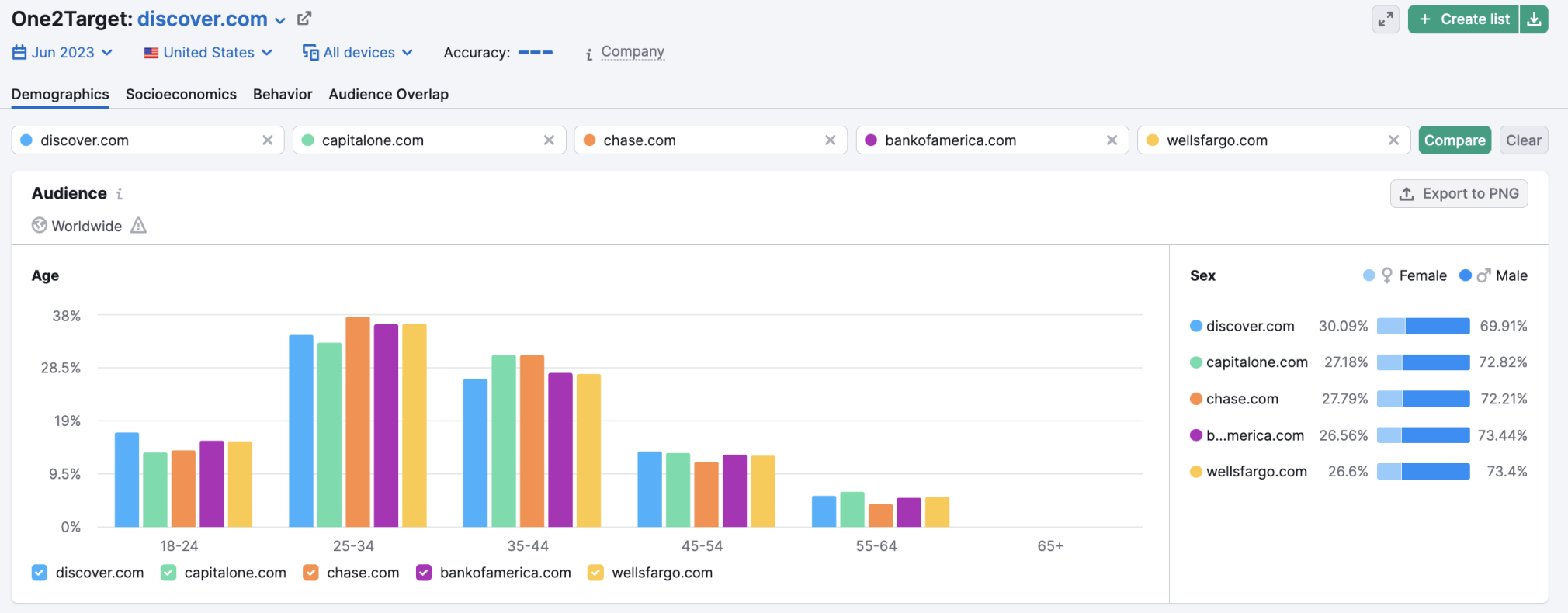
Overall, we can see that the majority of audience members for our domains are men aged 25-34. There’s also a large segment in the 35-44 age range.
Looking at the individual players, however, we notice some distinctions. For example, it looks like Discover’s audience in the 18-24 age range is larger than their competitors, while chase.com has a larger hold on the 25-34 age range. Knowing this can help us think about how we want to position our business and which audiences we want to approach.
One2Target can also provide insights into audience overlaps. For example, in the Audience Overlap report, we can see discover.com has the largest audience overlap with chase.com.
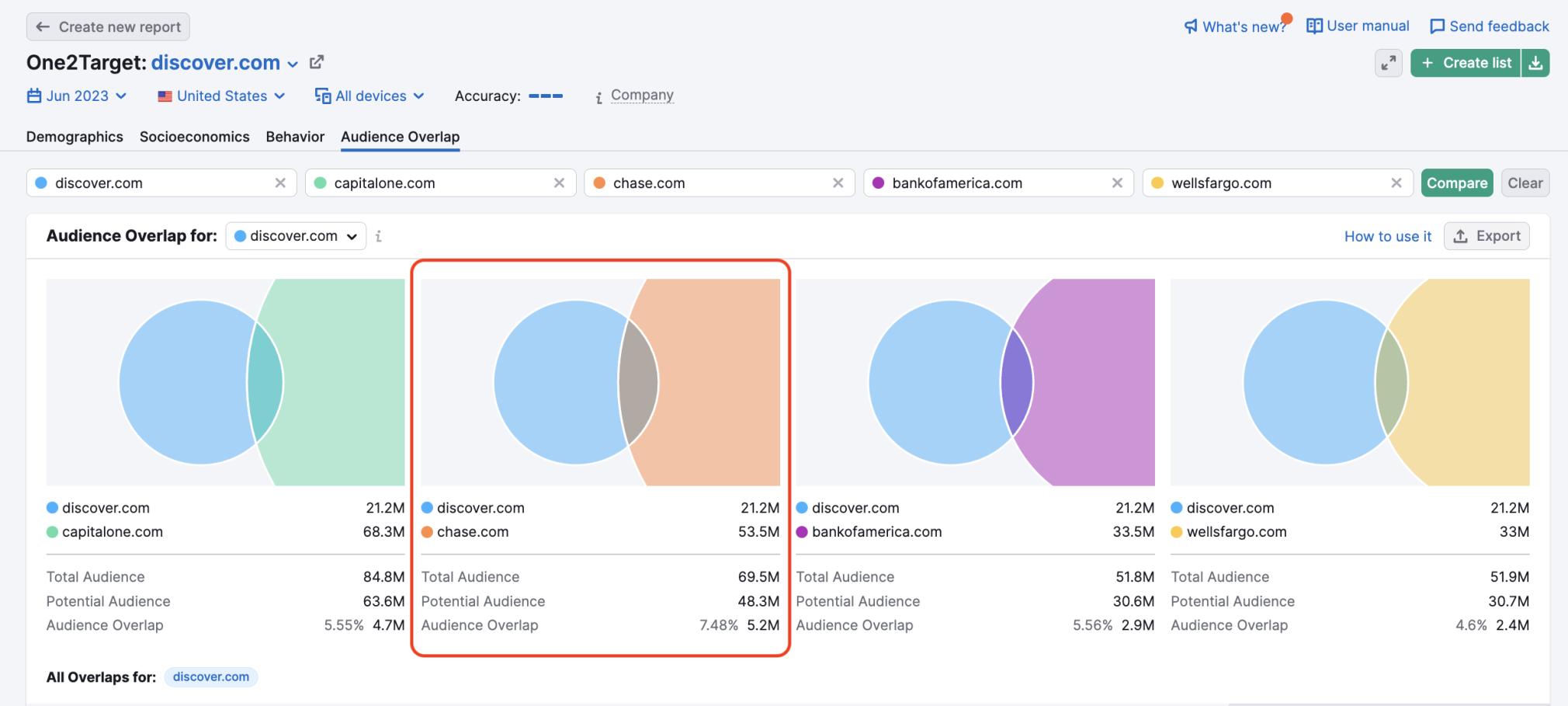
The potential audience Discover could gain by targeting Chase’s audience is a massive 48.3M people. And using the visited domains report, we can find out where Chase’s audience spends their time online to inform our ad and partnership strategies.
For example, if we wanted to target a younger demographic, we filtered the list by the Computer & Video game category and here’s what we uncovered.

Looking at domains that chase.com’s audience overlaps with in the computer and video game category, we discovered a few potential targets for ads and partnerships.
For example, 3.7M users who visited chase.com also visited twitch.tv. This presents a potential audience of 5.6M individuals we might reach with a target ad campaign or partnership with this site.
1. Analyze Competitor Activity Across the Market Landscape
Using Market Explorer, let’s get an overview of the competitive landscape and see which players are making the biggest gains. The Growth Quadrant found in the Market Explorer Overview report is your go to for competitive landscape analysis.
Here’s a look at traffic growth for top players in the industry.

Here, we discover americanexpress.com has seen a 31% growth in traffic over the past year, pushing them from the Game Changers category almost into the Leaders category.
You can also select different metrics to define your X and Y-axis to see how different competitors have experienced growth or declines along various criteria. For example, we selected Traffic for our X-axis and Purchase Conversions for our Y-axis.

Here, we found a different competitive layout. For example, capitalone.com has seen solid growth in their Direct Traffic and a 870% increase in purchase conversions.
By identifying what competitors are showing the best results for different kinds of metrics, you can figure out who to watch and where to look for insights to apply to your own strategy.
2. Unpack Competitor Traffic Acquisition Strategies
We identified americanexpress.com as one of the fastest growing domains in our market. Let’s turn to the Traffic Analytics tool to better understand their traffic acquisition strategy.
The Traffic Channel by Type widget is a great place to start examining competitor traffic. It allows you to choose a specific traffic channel, view the traffic trend over time, and track growth month by month.
For example, it looks like americanexpress.com has seen a strong uptick in Referral traffic over the past year. November, December, and January were especially strong months for Referral traffic.
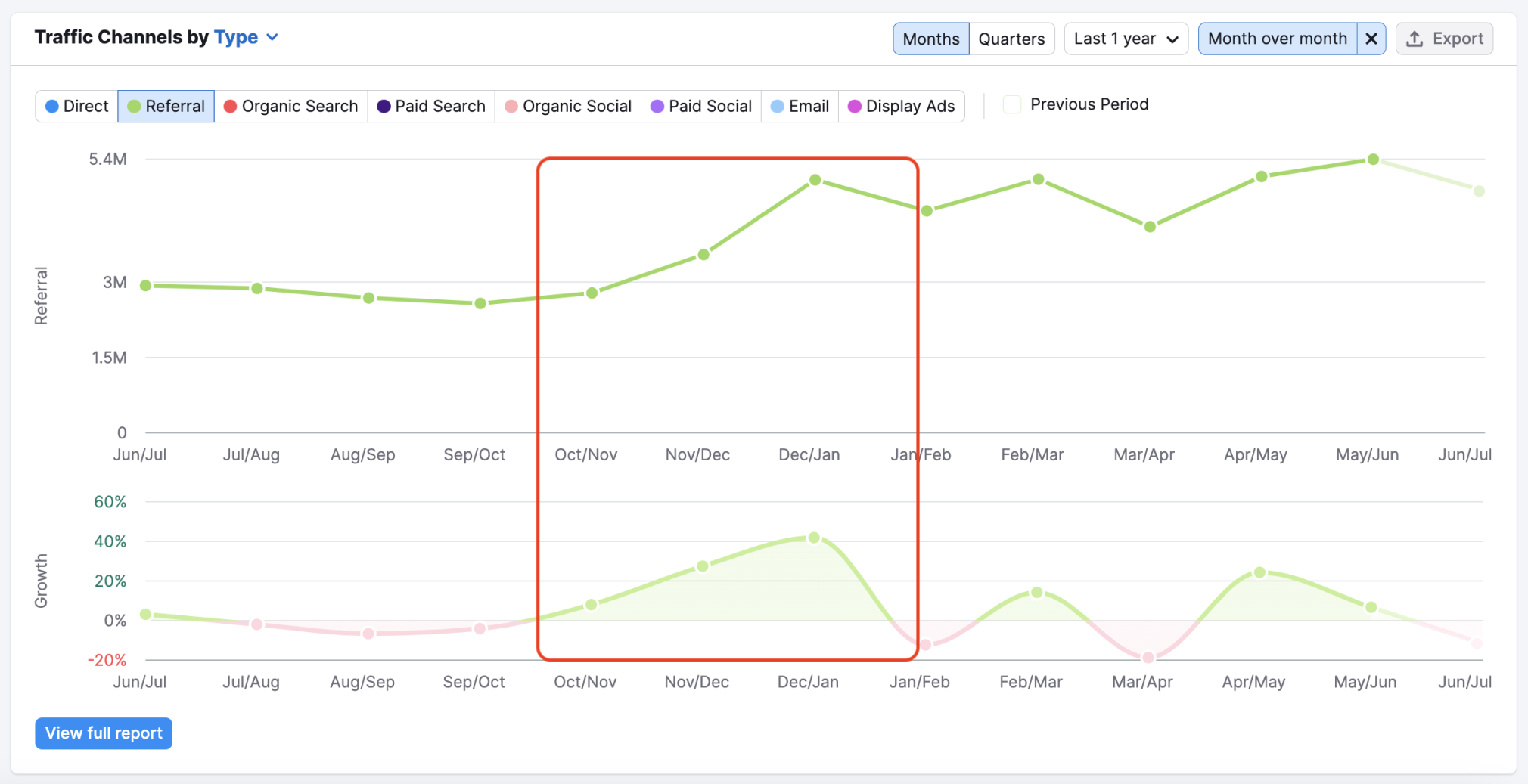
Likewise, they’ve been investing in their Paid Social strategy. They saw a massive 140% growth between October and December of 2022.
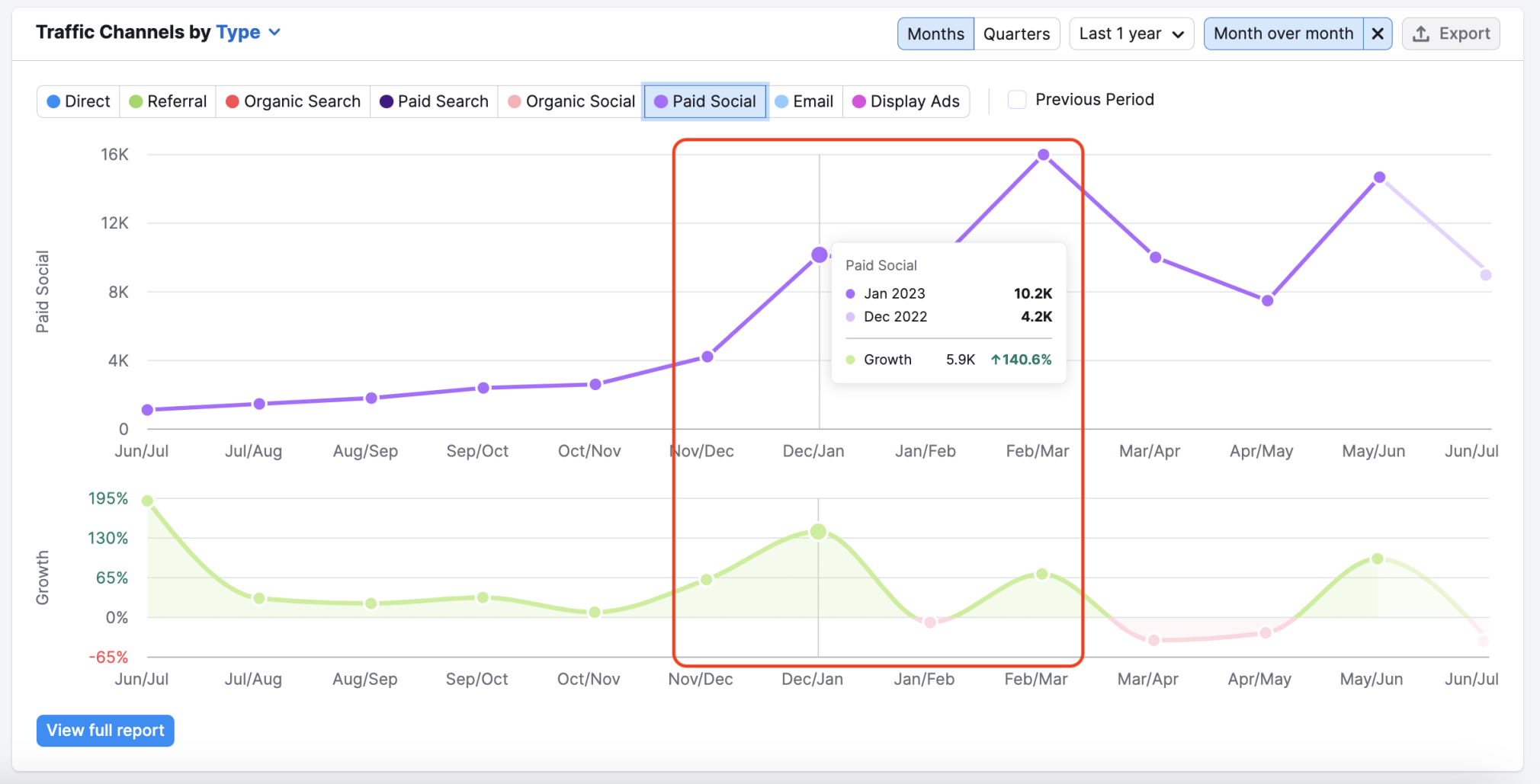
Once we discover the channels where they’re seeing growth, we can dig deeper with the Traffic Journey report. Here’s a look at the breakdown of their Paid Social traffic by platform.
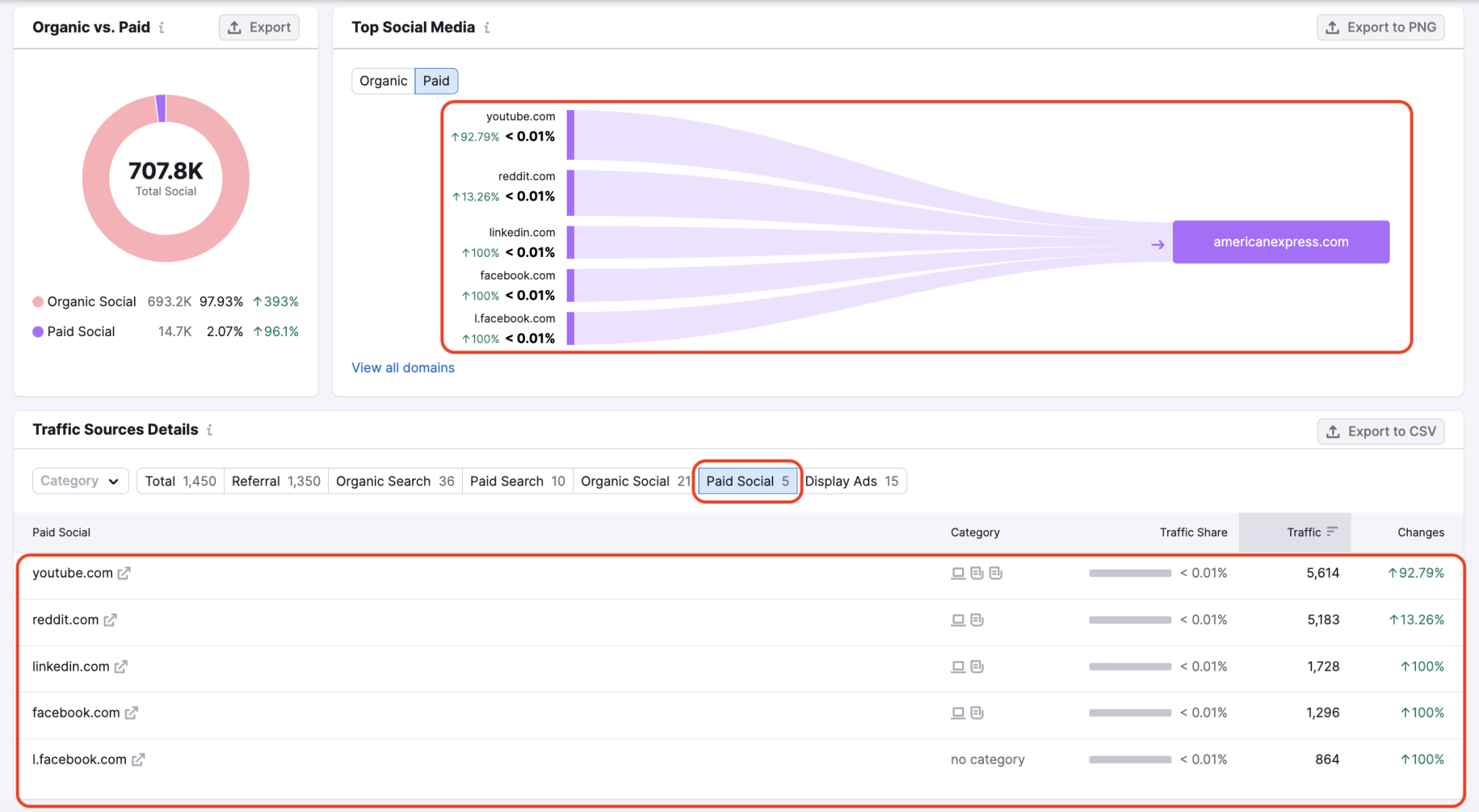
Looks like their driving a huge amount of traffic from youtube.com and reddit.com. It seems these platforms are especially impactful when it comes to their Paid Social marketing, which is a key piece of information we might bring to our own strategy.
3. Review Competitor Activity Related to Campaigns and Promos
Now that we know the Paid Social channel is key for americanexpress.com’s strategy, let’s turn to the Top Pages report to take a look at what products they’re promoting through this channel.
We organized the table by the Paid Social channel to bring the highest performing pages to the top of the list.
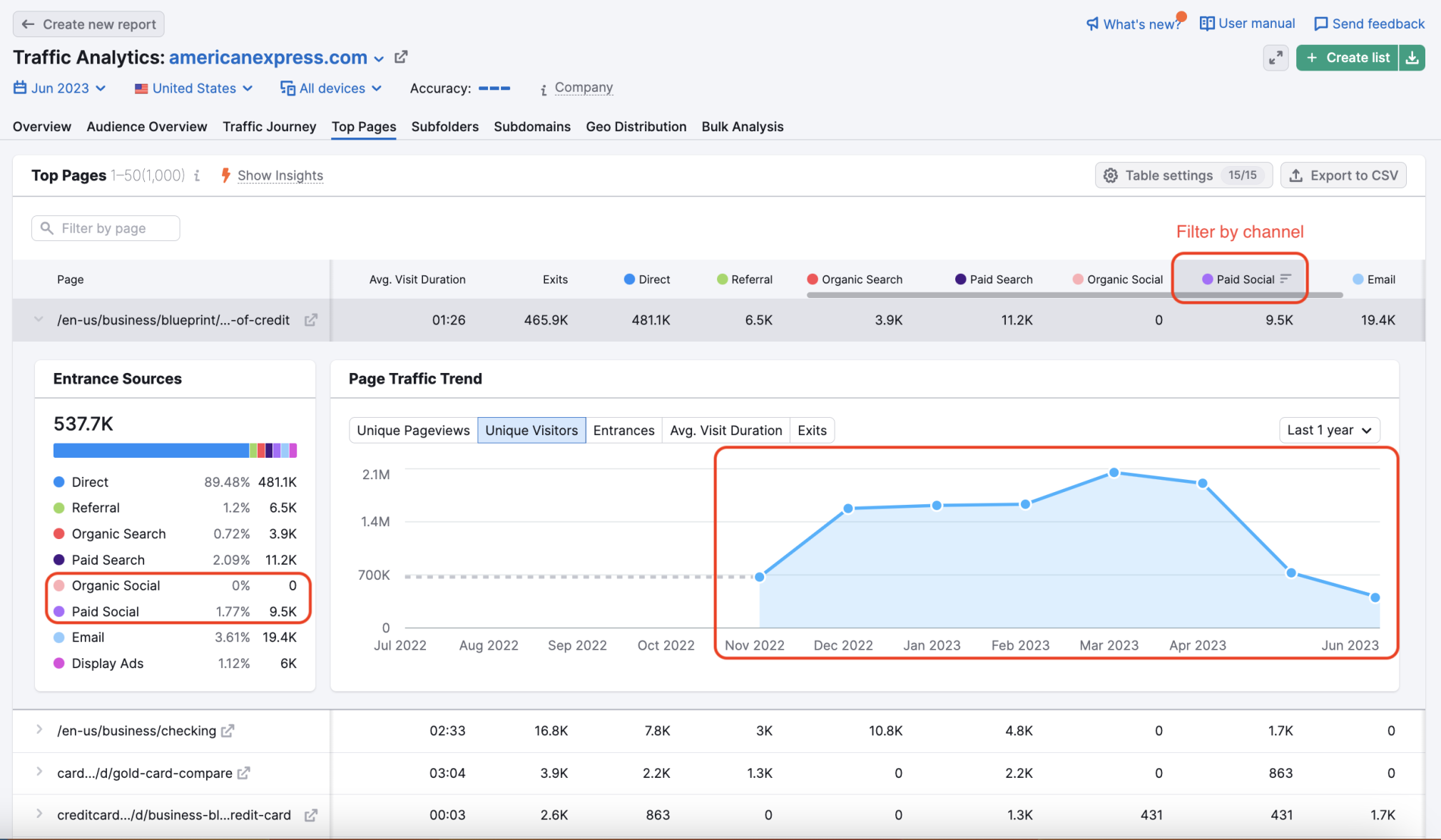
Here, we discover a promo for a business line of credit. It looks like the promo started in November 2022, and continued strong through March 2023. Traffic to the page has dropped off since April of 2023. When we follow the link, this is the page being promoted.
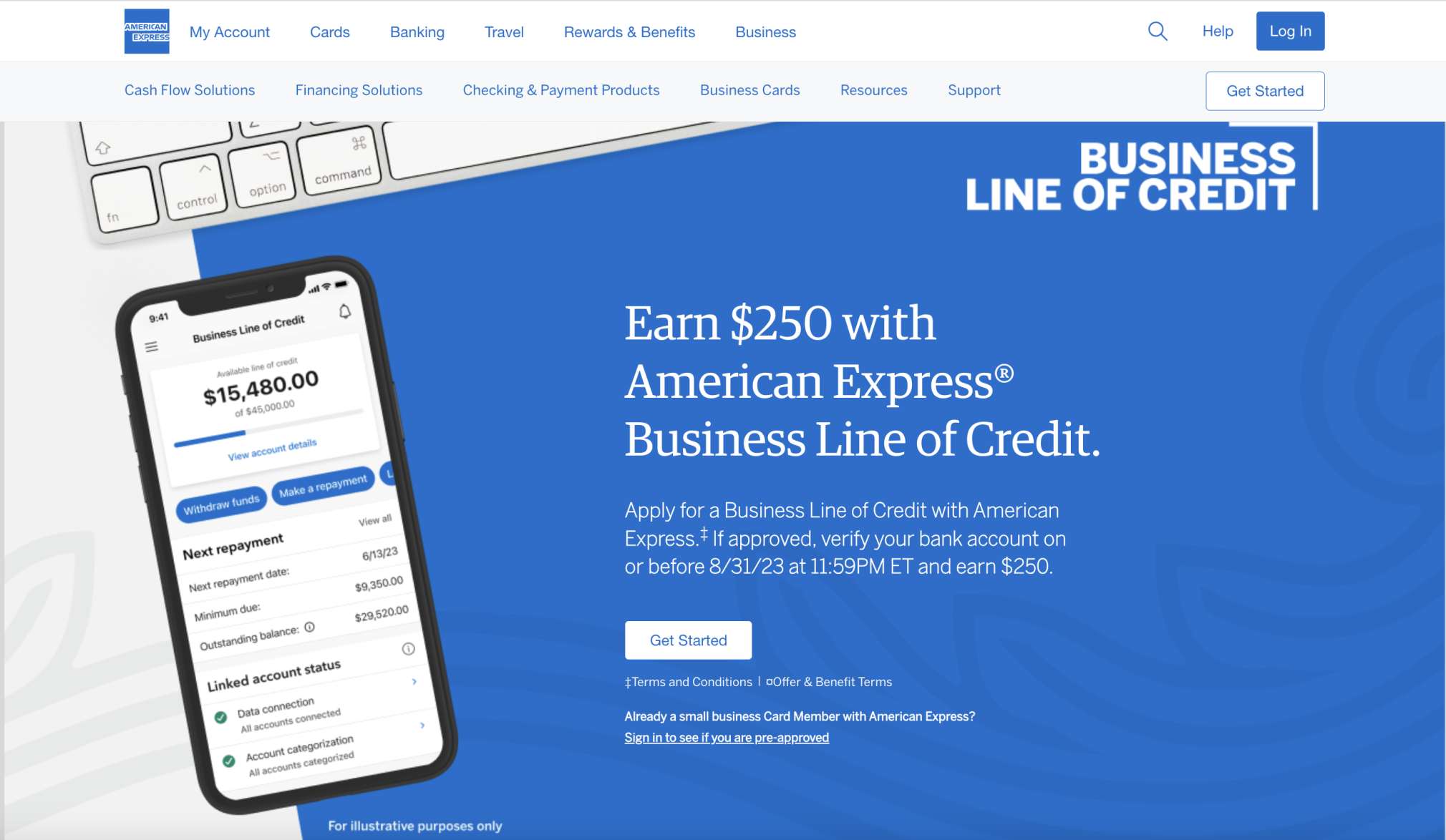
By exploring the top pages being promoted across various channels on competitor sites, you can understand what they’re offering, how they are positioning the offer, and what channels they’re using.
The combination of these insights can go a long way in helping you improve your own offers, positioning, and overall ad strategy.
4. Set Up Ongoing Competition Tracking to Stay in the Loop
Digital marketing competitor analysis is an ongoing process, and staying on top of competitor activity is crucial. Semrush’s EyeOn tool makes it easy to track competitors 24/7 so you never miss a beat.
Here, we entered our top credit card competitors along with their social media. We also turned on email alerts to get updates straight to our inbox. Here’s a look at the overview report which shows activity and trends for:
- All activity updates
- New web pages
- New blog posts
- Google Search Ads
- Social Media Posts
- Social Engagement

You can also gather activity data for a single domain by making a selection in the sidebar. For example, here’s a look at discover.com’s Google Search Ad activity.
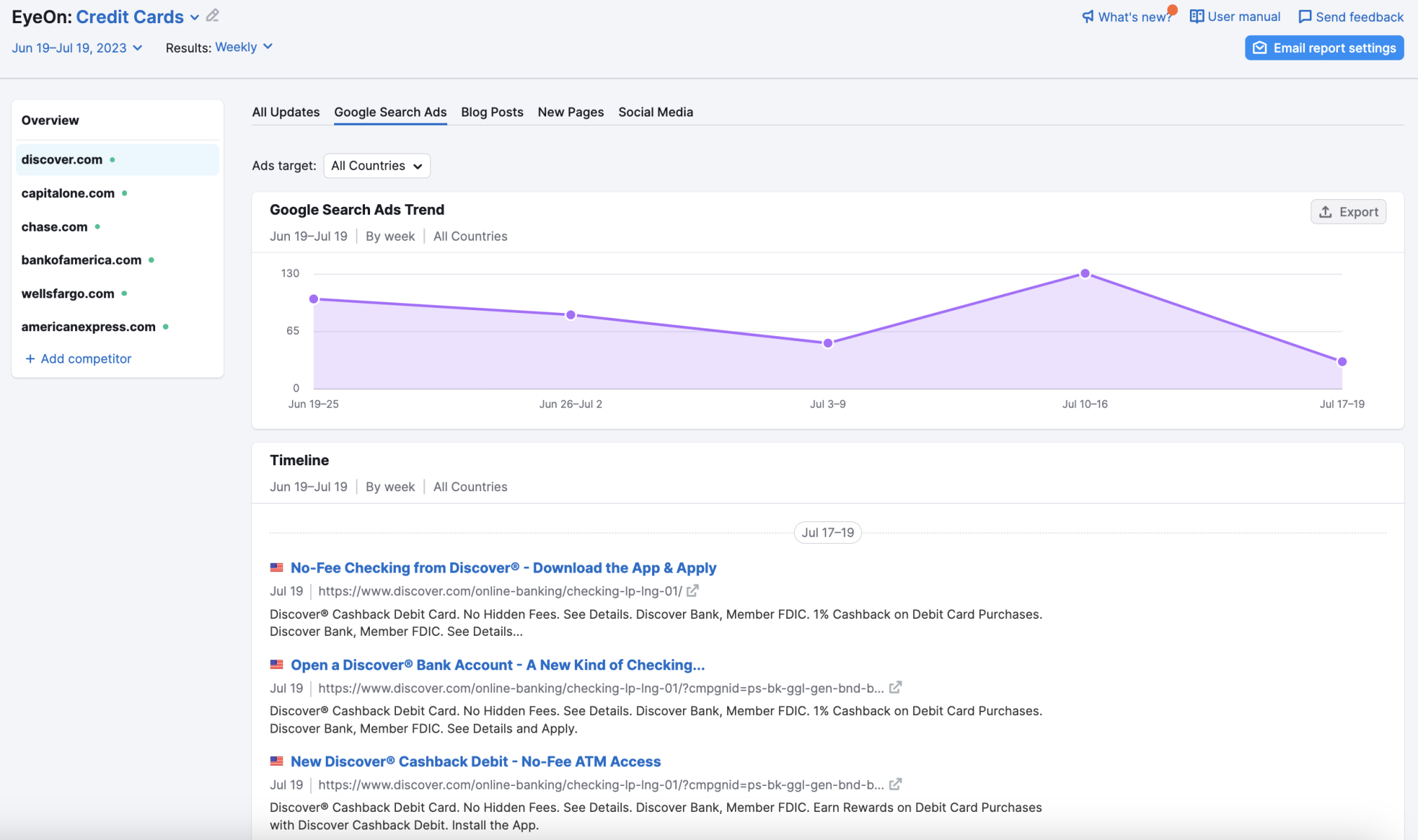
By tracking competitor activity data, you can identify new promos, shifts in competitor targeting, and new promos that will allow you to respond quickly to threats and take advantage of opportunities.
Analyze Competitor Activity Data With Your Own Goals and Strategy in Mind
Now that you’ve walked through the key steps of a recurring competitor analysis, you need to make sense of your findings.
- Assess how competing businesses’ actions and your marketing ideas correlate with your initial strategy.
You may discover that a long-term campaign you started six months ago doesn’t correspond to the current market trends and needs. Well, it’s definitely better to find out now than in another six months.
- Filter out any ideas that are not in line with your company’s offering, positioning, ultimate goals, or strategy.
No matter what brilliant insights you have found by looking at your competition, if they don’t align with your brand idea or roadmap, it’s better to push them to the back burner. And this is when the next point becomes crucial.
- Communicate competitive intelligence to other departments.
Competitor analysis can reveal insights that are not yet actionable for the marketing team but will be appreciated in the sales department, for example. Needless to say, any intelligence is invaluable for executives.
Think of those colleagues who could benefit from your findings and don’t hesitate to share your competitor analysis report with them.
- Encourage and initiate changes in your marketing plans and strategy (if needed)
If you’re halfway through your marketing campaign and, compared to rivals, it isn’t producing great results, don’t be afraid of making tweaks or even rethinking the entire strategy. At the end of the day, this is why you do competitor research: to discover greener fields and move to them as quickly as possible.
[ad_2]
Source link
About us and this blog
We are a digital marketing company with a focus on helping our customers achieve great results across several key areas.
Request a free quote
We offer professional SEO services that help websites increase their organic search score drastically in order to compete for the highest rankings even when it comes to highly competitive keywords.
Subscribe to our newsletter!
More from our blog
See all postsRecent Posts
- What Is It & Tips on how to Do It December 7, 2023
- What It Is and The way to Use It December 7, 2023
- High 10 Content material Repurposing Instruments for 2024 December 7, 2023


